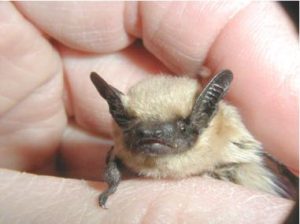
Western Pipistrelle (Pipistrellus hesperus) Image provided by the National Park Service (NPS), U.S. Department of the Interior on Wikipedia
Appearance
The Western Pipistrelle is covered in fur (excluding their wings) that ranges in color from reddish hues to medium browns. They have white or light-colored underbellies, black faces, a club-shaped tragus, and tiny black ears that stand straight up at the sides and tops of their head. Their wings are hairless, and are short and broad (between 7 and 9 inches wide), giving them agile flying abilities.
Habitat and Hibernation
The Western Pipistrelle are generally found in rocky areas near water sources, like canyons, caves, and cliffs; and can sometimes be found living under loose rock beds. Regionally, they are found across Washington through the western United States, and to southern parts of Mexico. Their hibernation practices are still unclear, as many researchers have speculated that colonies travel short distances to warmer climates; but we do know they hibernate in caves, old mines, and crevices of rock.
Reproduction and Life Span
Western Pipistrelle bats live an average of 10 to 13 years in the wild. Unlike other bat species, they do not form large maternity colonies for the purpose of reproduction. Instead, female bats will share large rock crevices with other gestating females. One pup is born at a time, usually between early and late summer.
Species Status
The Western Pipistrelle is not currently listed as an endangered or threatened species, as it is one of the most common species of bat in many southern regions. Common predators include some species of owl and even other larger bat species.

